Prostate surgery is a common procedure used to treat conditions such as benign prostatic hyperplasia (BPH) and prostate cancer. Whether you’re preparing for your first consultation or heading into recovery, understanding the process can ease anxiety. It can also lead to better outcomes.
In this article, we’ll guide you through the pre-surgery preparation. We will also explain the procedure itself. You will know what recovery looks like. We ensure you’re informed at every step of your journey.
🔍 What Is Prostate Surgery?
Prostate surgery refers to the surgical removal or partial resection of the prostate gland. It is primarily recommended for:
- Enlarged prostate (BPH)
- Prostate cancer
- Urinary retention or obstruction
The most common types include:
- TURP (Transurethral Resection of the Prostate)
- HoLEP (Holmium Laser Enucleation of the Prostate)
- Radical prostatectomy (for prostate cancer)
Learn more about TURP vs. HoLEP ➜
🩺 Before Prostate Surgery
1. Initial Evaluation
You will undergo:
- PSA test (Prostate-Specific Antigen)
- Digital Rectal Exam (DRE)
- Imaging (MRI, ultrasound)
2. Preoperative Instructions
Your urologist will advise:
- Stopping certain medications (like blood thinners)
- Fasting for 6–8 hours before surgery
- Arranging post-op care or transport
Tip: Choose a specialist urologist with expertise in both open and minimally invasive prostate surgery.
🟩 Internal Link Suggestion: Meet Dr. Saurabh Mishra – Expert in Prostate Care ➜
🏥 During the Surgery
Depending on your diagnosis, your urologist may perform one of the following:
- TURP: A minimally invasive option for BPH
- HoLEP: Laser-based technique offering faster recovery
- Robotic Prostatectomy: High precision treatment for prostate cancer
Anesthesia (general or spinal) is used, and the procedure usually lasts between 1–3 hours.
🟩 Internal Link Suggestion: Latest Urological Treatments Available ➜
🛌 After Prostate Surgery: Recovery Guide
⏳ Immediate Post-Surgery
- You may have a catheter for 1–3 days
- Hospital stay: 1–2 days (sometimes same-day discharge)
- Mild discomfort or urinary urgency is normal
🏠 At Home Recovery
- Avoid lifting heavy objects for 2–4 weeks
- Drink plenty of water
- Resume light activity within a few days
🚫 Watch Out For:
- Blood in urine (mild is normal)
- Fever or chills
- Painful urination
Always follow up with your urologist for post-op evaluations.
🧬 Long-Term Outcomes of Prostate Surgery
- Improved urinary flow
- Reduced symptoms of BPH
- In cancer cases: effective removal of tumors with close monitoring
⚠️ Possible Side Effects
- Temporary incontinence
- Erectile dysfunction (less common with nerve-sparing techniques)
- Retrograde ejaculation
🔗 Trusted Resource: American Urological Association – BPH Treatments
📞 Need Personalized Care?
At Dr. Saurabh Mishra Advanced Urology Care, we provide comprehensive prostate evaluations, advanced surgical techniques, and compassionate recovery support.
🟩 Book a consultation now ➜ Click here to schedule an appointment
✅ Final Thoughts
Prostate surgery is a safe and effective treatment for many men experiencing urinary issues or prostate cancer. Knowing what to expect before the procedure is important. Understanding what happens after the procedure will help you feel confident and in control of your health journey.
🔎 Keywords Used:
- Prostate Surgery (main)
- BPH
- TURP
- HoLEP
- Robotic prostatectomy
- Recovery after prostate surgery




